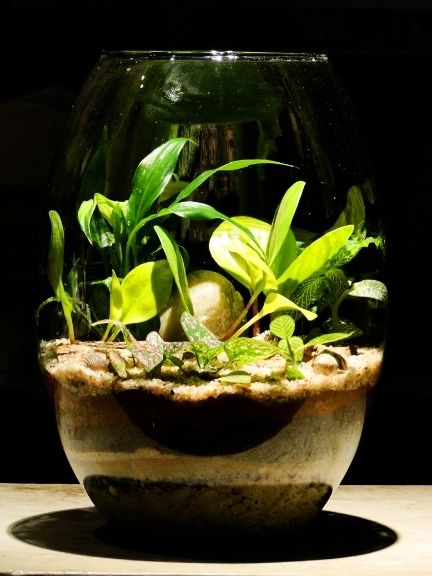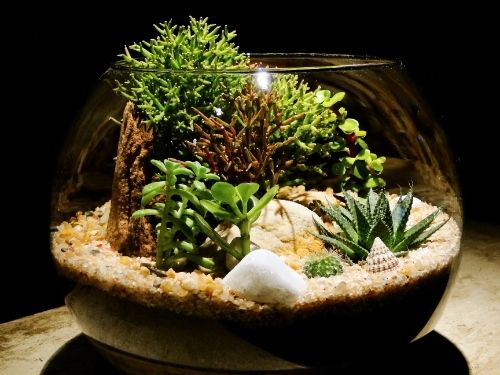This page may contain affiliate links that allow us to make a small commission from qualifying purchases (at no extra cost to yourself). We appreciate your support.
Terrariums are an excellent way for indoor gardeners to enjoy their beautiful plants without much time and effort compared to ordinary indoor houseplants. Terrariums are self-nourishing plant habitats, and if sealed correctly, they will require little maintenance. How many plants should be in your terrarium?
A terrarium fitting three 2″ plants should be roughly 6″ in diameter. It would be best to give plants some space in your terrarium, and it is advised to give your plants at least 30% of the terrarium for free space. A bigger terrarium provides you with more freedom for decorations.
The size of your terrarium container will be one of the first things you need to consider before building your terrarium. The size of your container has a significant influence on your plants. How can you determine how many plants should be in your terrarium? Read on to find out!
Determine How Many Plants To Put In Your Terrarium
A typical terrarium that can fit three 2″ plants should at least be 6″ either in diameter or width. A bigger terrarium will make it possible to accommodate larger plants and more plants.

A more miniature terrarium will be your best bet if you have smaller plants with more defined foliage. When determining how many plants you can put in your terrarium, you should consider whether your existing plants fit into the container.
In general, you need to leave enough room for the plants inside your terrarium to grow without getting into contact with the sides of your terrarium. If you have a 6″ terrarium, you would be able to fit roughly three 2″ plants.
For a bigger terrarium of 8″, you can comfortably accommodate four to five 2″ plants.
Most of the time, you can look at the diameters of your plants and then compare them to the width or length of your terrarium.
However, there are some mathematical calculations you can do if you want a more accurate answer. All you have to do is accurately measure the size of your terrarium and compare these numbers with the size of your plants. Add up the dimensions of your plants, and make sure it is about equal to the size of your terrarium.
Compare your container area size to the combined plant sizes. Make sure to allow extra room for growth.
You can usually expect the height of some smaller terrarium plants to range from 1 to 6 inches. Medium-sized terrarium plants will usually go in sizes from 6 to 12 inches. If you’re opting for taller plants, you can expect them to be around 12 inches.
You must ensure that you give your plants sufficient space around each of them, as this will account for the drainage layer and the ground supporting your plants and their roots.
When it comes to the total height of your terrarium plants, you need to aim for about two to three extra inches of space after you have predicted the approximate size of the tallest plant in your terrarium.
However, it would be best to keep in mind that the bigger the plant, the deeper your substrate layer should be; there will be a big possibility that you will need to add an extra layer to your terrarium if you have bigger plants.
Most gardeners want their terrariums to look as good as possible. Still, if you aren’t too worried about your terrarium’s looks, you don’t have to pay too much attention to the scale of your plants. However, this would be a helpful guide for you to estimate how well your plants will fit in when you consider your terrarium’s aesthetic.
Choosing The Correct Size Terrarium
The size of your terrarium is one of the essential factors you will need to consider. It could be challenging to figure out which size you should use. However, as a rule of thumb, a giant terrarium would be better, giving your plants more space to spread out and grow.
It is advised to leave roughly ⅓ of the space in your terrarium open. With a giant terrarium, you will have more freedom as well.
You are free to fill this space with decorations, features, some more plants, and any other creative elements that you want to feature in your terrarium.
The Size Of Your Terrarium Impacts Your Plants’ Health
Did you know that the size of your terrarium will significantly influence the overall health of your plants? A factor overlooked by even the most experienced terrarium owners could cause their plants to look sick and even cause their death.
There are several reasons for this, and you might be surprised to find them out! If you are working with a smaller-sized terrarium, it could become challenging for you to follow all the requirements for a flourishing self-sustaining ecosystem.
When you scale your terrarium’s size down too far, it could become almost impossible to achieve sufficient evaporation, water drainage, and condensation instead of using a larger terrarium.
When you choose a smaller size terrarium, you will also become more restricted in the type of plants you will be able to choose.

You will also be unable to add creative elements, higher plants, and drainage enhancing components to your terrarium. While these problems are certainly solved with a larger terrarium, larger terrariums will also provide you with numerous other benefits.
Aside from you being able to fit a broader range of plants in a bigger terrarium, the extra space will act as a shield against any adverse effects, such as rot, mold, disease, and over-watering.
This is because these symptoms will take more time to spread in a bigger terrarium. It is also because the normal state in your larger terrarium will not change as much with these small outbreaks.
Conclusion
For your terrarium to succeed, in the long run, you must know what size will accommodate the amount of desired plants you want to place in them. The size of your plants will impact the terrarium’s drainage abilities and water retention abilities.
More than often, estimating with your eyes will be enough, and it will not be needed for any mathematical equations. However, if you want the most accurate estimate, you can bring math into the mix!

Meet Brad, the creator behind Vivarium Vibes, where his deep connection with nature and animals truly comes to life.
